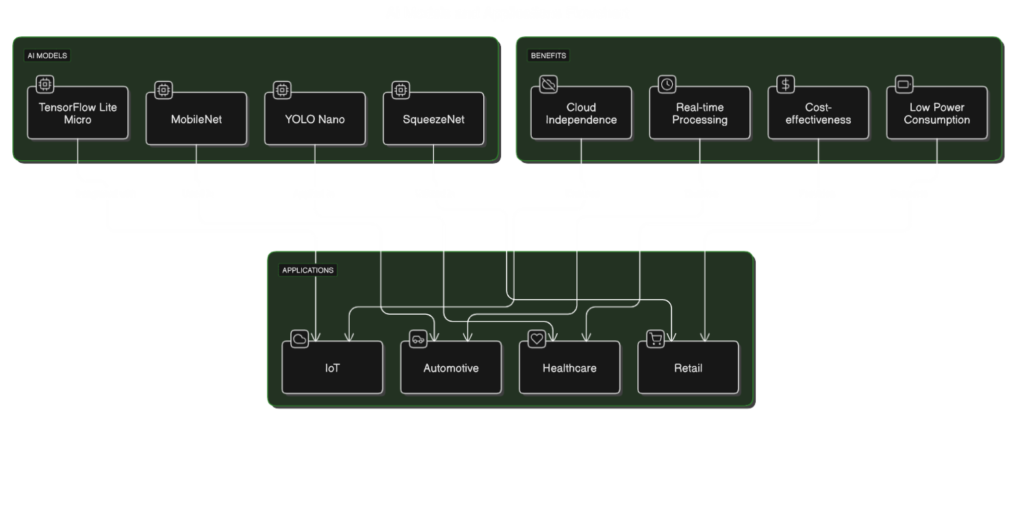Imagine this: Your smartwatch doesn’t just count steps—it understands your daily habits, predicts health risks, and communicates seamlessly—all while consuming minimal power. Sounds futuristic? This is the power of Tiny AI, a groundbreaking innovation enabling powerful intelligence on the smallest devices.

In this article, we showcase the best Tiny AI models optimized for edge devices, highlight their real-world applications, and explore how they’re transforming industries like healthcare, retail, and automotive. Let’s dive in!
🔍 Top Tiny AI Models Optimized for Edge Devices
1. MobileNet
- 👨💻 Developed by: Google
- 📚 Use Cases: Object detection, image classification, face recognition.
- ✨ Why It’s Best:
- Lightweight and fast for mobile and embedded applications.
- Extremely low power consumption.
- 💡 Examples:
- Google Nest Cameras: Real-time person detection.
- Smart Retail: Inventory tracking using image recognition.
2. TinyMLPerf Benchmark Models
- 👨🔬 Developed by: MLCommons
- 📚 Use Cases: Keyword spotting, visual wake words, anomaly detection.
- ✨ Why It’s Best:
- Designed for benchmarking edge AI performance.
- Optimized for ultra-low-power MCUs.
- 💡 Examples:
- Healthcare Wearables: Monitoring heart rate and detecting irregularities.
- Smart Home Devices: Voice activation with minimal resources.
3. YOLO (You Only Look Once) Nano
- 👨💻 Developed by: Joseph Redmon & TinyYOLO Contributors
- 📚 Use Cases: Object detection in constrained environments.
- ✨ Why It’s Best:
- Real-time processing for edge devices.
- Scaled-down for low resource consumption.
- 💡 Examples:
- Drones: Real-time obstacle detection.
- Retail Surveillance: Monitoring for suspicious activities.
4. Edge Impulse Models
- 👨💻 Developed by: Edge Impulse
- 📚 Use Cases: Keyword detection, vibration analysis, motion detection.
- ✨ Why It’s Best:
- Tailored for specific edge applications.
- Seamlessly deploys on MCUs like STM32 and Arduino.
- 💡 Examples:
- Industrial IoT: Predictive maintenance.
- Smart Agriculture: Monitoring crop health via sensors.
5. TensorFlow Lite Micro
- 👨💻 Developed by: Google
- 📚 Use Cases: Speech recognition, anomaly detection, gesture recognition.
- ✨ Why It’s Best:
- Runs on ultra-low-power microcontrollers.
- Integrated into TensorFlow’s ecosystem.
- 💡 Examples:
- NXP Semiconductors: Speech models on i.MX RT MCUs.
- Smart Toys: Enabling interactive speech-based features.
6. OpenVINO Toolkit Models
- 👨💻 Developed by: Intel
- 📚 Use Cases: Image recognition, human pose estimation, anomaly detection.
- ✨ Why It’s Best:
- Optimized for Intel hardware acceleration.
- Supports CPU, GPU, and VPU devices.
- 💡 Examples:
- Healthcare: Portable ultrasound systems.
- Retail: Enhanced customer analytics with visual AI.
7. SqueezeNet
- 👨💻 Developed by: DeepScale (Tesla)
- 📚 Use Cases: Real-time image classification.
- ✨ Why It’s Best:
- Compact size with competitive accuracy.
- Perfect for embedded vision systems.
- 💡 Examples:
- Autonomous Vehicles (Tesla): ADAS object detection.
- Security Cameras: Low-power video analytics.
8. TinyBERT
- 👨💻 Developed by: Huawei
- 📚 Use Cases: Natural Language Processing (NLP) on edge devices.
- ✨ Why It’s Best:
- Compact BERT version for constrained devices.
- Excels in conversational AI.
- 💡 Examples:
- Customer Support Bots: Real-time chat systems.
- Wearables: Voice-based command processing.
9. FastText
- 👨💻 Developed by: Facebook AI
- 📚 Use Cases: Text classification, sentiment analysis, keyword spotting.
- ✨ Why It’s Best:
- Extremely fast and lightweight for NLP tasks.
- Ideal for constrained environments.
- 💡 Examples:
- Social Media Monitoring: Sentiment analysis.
- Embedded Assistants: Text queries on resource-limited devices.
10. TinyVisionNet
- 👨💻 Developed by: Arm
- 📚 Use Cases: Visual wake words, simple vision tasks.
- ✨ Why It’s Best:
- Optimized for ARM Cortex-M CPUs.
- High efficiency for IoT applications.
- 💡 Examples:
- Smart Doorbells: Detecting people at your doorstep.
- Energy-Efficient Cameras: Critical event detection with low power.
🔗 Choosing the Right Model for Your Use Case
| Model | Best For | Industries | Companies Leveraging It |
| MobileNet | Object detection | Automotive, Retail | Google, Amazon |
| TinyMLPerf Models | Anomaly detection | Healthcare, Smart Homes | Fitbit, Philips Healthcare |
| YOLO Nano | Real-time object detection | Security, Drones | DJI, Ring |
| Edge Impulse Models | Custom edge applications | Agriculture, Industrial IoT | Bosch, Siemens |
| TensorFlow Lite Micro | Speech recognition | Consumer Electronics | NXP, STMicroelectronics |
| OpenVINO Models | Image recognition | Healthcare, Retail | Intel, Zebra Technologies |
| SqueezeNet | Vision-based AI | Automotive, Security | Tesla, Hikvision |
| TinyBERT | Edge NLP | Smart Assistants | Huawei, Microsoft |
| FastText | Text analysis | E-commerce, Social Media | Meta, Shopify |
| TinyVisionNet | Vision AI for IoT | Smart Homes, Wearables | Arm, SmartThings |
🏁 Conclusion
These Tiny AI models empower industries with smarter, more efficient edge AI solutions. By combining intelligence with resource optimization, they enable real-time, scalable applications across healthcare, agriculture, retail, and beyond.
🌟 Ready to unlock the power of Tiny AI? It’s time to make edge AI work smarter—not harder!